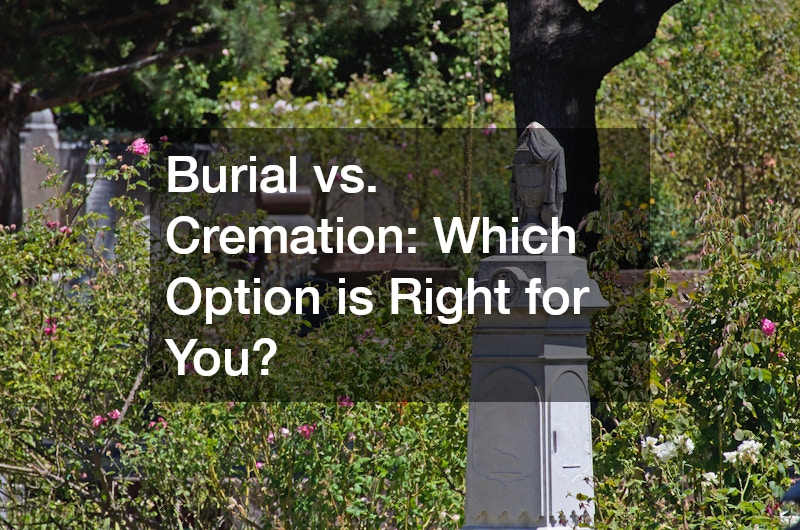
The decision between burial and cremation is deeply personal and often influenced by various factors such as traditions, costs, and environmental considerations. Understanding these options ensures that the choice aligns with one’s values, religious beliefs, and financial situation. This article delves into the intricacies of burial and cremation to help you make an informed decision.
What Are the Cost Differences Between Burial and Cremation?
Understanding Burial Costs
Traditional burial can be associated with several costs such as purchasing a burial plot, which can significantly vary depending on the location. Additional expenses may include the casket, which is often one of the most expensive items in this process, and the headstone or grave marker. Other services, like embalming and transportation, contribute to the overall expenditure, highlighting the financial commitments of choosing a burial.
Selecting a burial option often requires considering costs beyond just the plot and casket. Funeral services, including the ceremony and any viewing arrangements, add significantly to the financial burden. Further, maintenance fees for the burial site may apply in perpetuity, creating an ongoing financial obligation for surviving family members.
Pre-planning and preparing a detailed budget can help ease the financial strain. Some families opt for simpler burial options to reduce expenses while still honoring their loved ones’ wishes. Understanding all associated costs allows families to make decisions that fit within their financial means while providing a meaningful tribute.
Breaking Down Cremation Expenses
Cremation is often seen as a more affordable alternative to traditional burials. Fees typically include the cremation procedure itself, which is usually less expensive than a full burial service. Other associated costs might involve purchasing or renting an urn for the final resting place of the ashes.
The cost of cremation can also vary widely, influenced by the choice of a memorial service, if any. Some families choose direct cremation without additional services to minimize expenses further. While not without its costs, cremation generally offers more flexibility in terms of reducing financial outlays compared to burial.
Alternative options within cremation services, such as cardboard containers instead of more elaborate urns, can affect the total expense. Additionally, many organizations offer package deals for cremation that include various services at a lowered cost. There is also the consideration of loved ones’ travel expenses if the memorial service is conducted at a different location than the crematorium.
Comparing Long-Term Financial Implications
When evaluating the long-term financial implications, it’s important to consider ongoing costs associated with both burial and cremation. Burials often come with perpetual maintenance fees for grave upkeep. These recurring costs can accumulate and become a financial strain for families over the years.
Cremation, on the other hand, might not incur such regular expenses. However, costs can arise if families choose to purchase plots in columbariums or to install permanent memorials for the ashes. Factoring in these considerations allows families to assess the long-term financial impact of their choice.
How Does Each Option Affect the Environment?
Environmental Impact of Traditional Burial
Traditional burials utilize significant resources, including land space that could otherwise serve ecological purposes. The materials required for burials, such as metal or hardwood caskets, often involve resource-intensive production processes. In addition, embalming fluids contain chemicals like formaldehyde, which pose environmental risks.
The use of resources and chemicals in burials raises questions about sustainable practices. Cemetery operations can impact local ecosystems, disrupting native habitats and consuming natural resources. As environmental consciousness grows, alternative, and more sustainable burial practices are being explored.
Choosing environmentally friendly options, such as biodegradable caskets or natural burial sites, can mitigate some of these impacts. Green cemeteries, which minimize environmental disruption, are becoming increasingly popular. These options offer a compromise between honoring traditional practices and being mindful of ecological implications.
Environmental Considerations for Cremation
Cremation involves the release of emissions and the consumption of significant energy. These factors contribute to its environmental impact, particularly regarding greenhouse gases. However, advancements in technology are being made to reduce these emissions, making cremation more eco-friendly.
Despite its environmental drawbacks, cremation requires considerably less land use compared to traditional burials. This is significant in urban areas where land availability is limited. Selecting facilities with modern, eco-efficient technologies can further reduce the ecological footprint of cremations.
Crematoriums are increasingly committing to environmentally conscious policies. Through technological improvements and regulatory compliance, the environmental effects of cremation can be lessened. These efforts align with society’s broader move towards sustainable practices.
Deciding between burial and cremation involves careful consideration of various factors, including cost, environmental impact, and personal beliefs. With rising awareness of environmental issues, many are exploring green alternatives that respect both personal values and the planet. Ultimately, the choice should reflect your financial situation, ecological consciousness, and cultural preferences.
.


